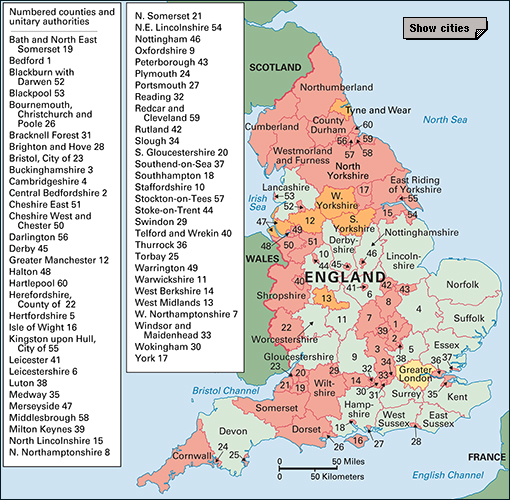Buckinghamshire (pop. 553,078) is a unitary authority, a type of local government area, in southern England, near London. The Buckinghamshire unitary authority includes most of the historic county of Buckinghamshire. The unitary authority’s administrative center is Aylesbury. The Milton Keynes area, in the northeastern part of the historic county of Buckinghamshire, forms a separate unitary authority. Buckinghamshire is also a ceremonial county. It covers the same area as the historic county. The British monarch appoints royal representatives, including a lord lieutenant and a high sheriff, to each of England’s ceremonial counties.

The area of the historic county of Buckinghamshire was reduced in a reorganization of local government in 1974. Part of southern Buckinghamshire, including the towns of Eton and Slough, was taken into the county of Berkshire. Buckinghamshire was further reduced in size in 1997, when Milton Keynes became a unitary authority. In 2020, the Buckinghamshire Council unitary authority replaced the Buckinghamshire County Council and the district councils of Aylesbury Vale, Chiltern, South Bucks, and Wycombe.
People and government
Most of Buckinghamshire’s people work in local manufacturing and service industries. But in the south of the county, many people travel to London to work.
Recreation.
A variety of sports are played in Buckinghamshire. The county has a cricket team in the minor counties league. Beaconsfield and High Wycombe have rugby football teams. Quality boating and fishing facilities are on the River Thames. An airfield near High Wycombe has a flying club and a gliding school.
Local government.
Buckinghamshire Council provides most local government services, including education, housing, garbage collection, and social services. Community boards in a number of Buckinghamshire communities meet to discuss local issues. Buckinghamshire shares a police force—the Thames Valley Police—with the counties of Oxfordshire and Berkshire. The police force headquarters is in Kidlington, in Oxfordshire. The Crown Court meets at Aylesbury.
Economy
Agriculture
is important in Buckinghamshire. The northern part of the county is almost entirely agricultural. Milk production is the most widespread farming activity. Farmers keep many beef cattle and also breed some sheep. Some farmers grow barley, oats, wheat, and root crops.
In southern Buckinghamshire, market gardening flourishes. Many farmers in this area grow mushrooms.
Manufacturing.
High Wycombe has long been famous as a center of the United Kingdom’s furniture-making industry. Papermaking and printing have been important industries at both High Wycombe and Aylesbury. For many years, workers at Newport Pagnell made one of the world’s best-known high-performance automobiles, the Aston Martin. In addition, Amersham has been known as a radiochemical center, producing radioactive chemicals for hospitals and for science researchers.
Transportation and communication.
Some of Buckinghamshire’s many commuters, who travel to London daily to work, rely on public transport facilities. Main railroad lines crossing the county are the line from London to Glasgow, and the line from London to Nottingham and Manchester. The Grand Union Canal goes through the northeastern part of the county. A branch canal links it with Aylesbury.
The M40 motorway (highway), from London to Birmingham, runs through southern Buckinghamshire. It links in the county’s southeastern corner to the M25, the orbital highway around London. The A41, which goes through Aylesbury, was formerly Akeman Street.
There are no local daily newspapers, but most of the large towns publish their own weekly papers.
Land and climate
Location.
Buckinghamshire is a landlocked area. It is bounded on the north by the unitary authorities of West Northamptonshire and Milton Keynes; on the east by Central Bedfordshire, Hertfordshire, and London; and on the west by Oxfordshire. To the south lie the unitary authorities of Wokingham, Windsor and Maidenhead, and Slough, and a short stretch of the county of Surrey.
Land features.
The Chiltern Hills divide the county into two natural regions. To the south of the Chilterns lies a chalk plateau, well watered by a few small rivers. The southern half of Buckinghamshire is well wooded, but there are also large areas under cultivation. The northern half has a clay soil and is much flatter. Water and pasture are plentiful.
The Chilterns run from Dunstable in Central Bedfordshire to the River Thames beyond Reading, and on to the Wiltshire Downs. In Buckinghamshire, they reach a height of 850 feet (259 meters) near Wendover. The River Thames forms part of Buckinghamshire’s southern boundary.
Climate.
Buckinghamshire has a mild climate. However, damaging frosts settle in low-lying areas in winter. The average temperature in January is 37 °F (3 °C). The average temperature in July is 63 °F (17 °C). Rainfall in the county averages about 24 to 30 inches (60 to 75 centimeters) a year.
History
Remains of Roman times in Buckinghamshire include Roman villas at Tingewick, and Roman roads. Saxons invaded the area in the A.D. 500’s and conquered Aylesbury in 570. An important archaeological discovery of Saxon remains was a barrow (burial mound) at Taplow. In 888, King Alfred made Buckingham the county town (administrative center) of a new county, Buckinghamshire.
In Norman times, a number of wooden castles and Norman churches were built in Buckinghamshire. But the area became known for its lawlessness. The office of Steward of the Chiltern Hundreds was created in an effort to restore law and order.
In the 1300’s and 1400’s, John Wycliffe and the Lollards gained many followers in Buckinghamshire. The Martyrs Memorial at Amersham commemorates the followers who were burned at the stake. During the 1400’s, Buckingham became a center of the wool industry. But the industry declined in the early 1500’s. The assize court—that is, a court where cases are heard by traveling judges—moved from Buckingham to Aylesbury. Aylesbury became the county town.
Famous people associated with Buckinghamshire include the Quaker leader William Penn; the poets William Cowper, Thomas Gray, and John Milton; and the statesmen Edmund Burke and Benjamin Disraeli.
